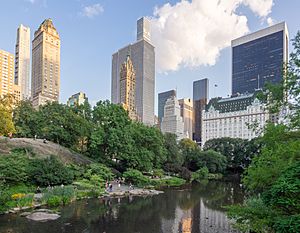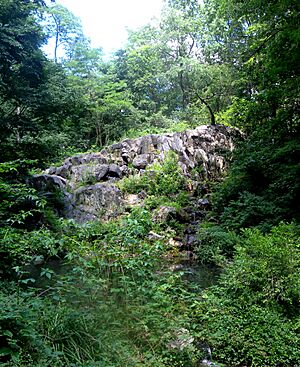The Pond and Hallett Nature Sanctuary facts for kids

The Pond and Hallett Nature Sanctuary are two special places connected in the southeast part of Central Park in Manhattan, New York City. You can find them near Grand Army Plaza, across from the Plaza Hotel, and close to Fifth Avenue. The Pond is one of seven water areas in Central Park.
Contents
Hallett Nature Sanctuary
The Hallett Nature Sanctuary is the smallest wooded area in Central Park. It is about 4 acres (1.6 ha) big. This area is the only part of Central Park that is always fenced off, except for the Jacqueline Kennedy Onassis Reservoir. It covers about 3.5 acres (14,000 m2) of a wooded hill next to the Pond.
History of the Sanctuary
The area was closed off in 1934. NYC Parks commissioner Robert Moses decided to make it a safe place for birds. For many years, the sanctuary was not well cared for.
In the 1980s, workers removed plants that did not belong there, like ailanthus and wisteria. They also thinned out some native black cherry trees. Then, they planted new shrubs that were native to the area.
The sanctuary was renamed in 1986. It was named after George Hervey Hallett Jr.. He loved watching birds and nature. He was also an important leader in the Citizens Union group.
Visiting the Sanctuary
The Hallett Sanctuary reopened to the public in 2016. The Central Park Conservancy now lets visitors enter the sanctuary during the middle of the day. They also offer short tours that last about 30 minutes.
These tours avoid times when birds are nesting or migrating. This is because Central Park is a stopover point for many birds on their long journeys. The edges of the sanctuary are great places for bird watching.
Sometimes, unexpected visitors come to the sanctuary. In 2002, an Asian longhorn beetle was found there. Also, a coyote nicknamed Hal the Central Park Coyote visited briefly in 2006. He got his name from the Hallett Sanctuary.
The Pond
When it was first designed by Frederick Law Olmsted and Calvert Vaux, the Pond was much larger. A big part of the Pond was later paved over. This area became the Wollman Rink, which opened in 1950.
Near the Pond, you can see statues of famous people. There are bronze busts of the poet Thomas Moore and the composer Victor Herbert.
Pond Restoration and Wildlife
The Central Park Conservancy started to rebuild the Pond in 2000. They finished the work the next year. This project added new plants along the shoreline. They also created an island for birds and turtles. Beyond Gapstow Bridge, they made small pools and waterfalls.
In late 2018 and early 2019, a male mandarin duck lived in the Pond. People nicknamed him Mandarin Patinkin. This duck became very famous around the world. People loved his colorful look. It was also unusual to see this type of duck, which usually lives in East Asia, in New York City.
Gapstow Bridge
The Pond is crossed by Gapstow Bridge. This bridge is made of schist rock. It was built in 1896 by Howard & Caudwell.
The current bridge replaced an older wooden bridge from 1871. That first bridge was designed by Jacob Wrey Mould. It had arches that rose above the bridge deck.


